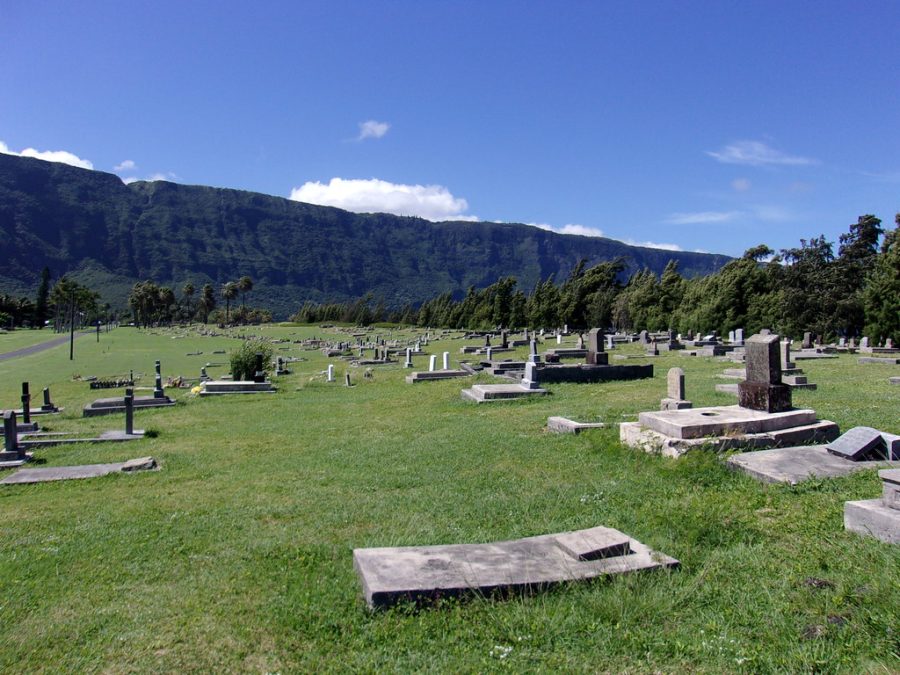The Meaning Behind a Grave
Kalaupapa Cemetery Kalaupapa, Molokai, Hawaii
May 17, 2022
When thinking of monuments, what likely comes to mind for most people are grandiose structures that memorialize someone who is important to history or serves a greater purpose in reminding people of an important lesson to be learned. While these ideas of what a monument should be are reasonable, it is not all that encompasses one. That idea is especially prevalent, and what many can overlook when thinking about monuments are the more intimate parts of life that can get pushed aside in the chaos of everyday routine. Although on a smaller scale, graves can still hold value as monuments for memorializing people of the past.
The purpose of a monument is to memorialize and build something that can remind others of someone who is important to be remembered. The power that a monument holds is something that should not be undersold. It is through these that people of the present can learn about the past they came from, and see a glimpse into the lives of those that came before us. By that definition, graves are irreplaceable monuments in the lives of everyday people. As Maya Lin, designer of the Vietnam Veteran Memorial in Washington D.C. states about her thoughts when designing the memorial, “The need for the names to be on the memorial would become the memorial; there was no need to embellish the design further. The people and their names would allow everyone to respond and remember.” Lin’s choice of names as the focus of the memorial is comparable to the way names are used on tombstones and graves. The ability that a name alone can serve to bring someone’s memory back is valuable because of the importance of remembering those who came before us.
In an article by William Spear on the Hansen-Spear Funeral Home website, he reflects this exact sentiment when he writes about seeing his parents’ and grandparents’ graves; “…it gives significance to lives well lived. These people helped mold me into what and who I am today. I literally owe them my life.” Both Lin and Spear give insight into the influence of remembrance, in that it is valuable for paying respects and thanks to the people who have shaped the futures of the lives of people today. Graves can do just that through their significance and presence, and it is for that reason that they are important monuments in society today, and should not be overlooked.
Despite their importance for reflecting on the lives once lived, graves are beginning to be pushed to obscurity. One reason for this is that people are beginning to find less and less time to visit them with the growing chaos of modern life. This is especially apparent in cultures where there are traditions for visiting the dead, such as the Día de los Muertos or Qīngmíng jié, both festivals held for the memorial of the dead in Mexican and Chinese culture respectively. Many people often find themselves becoming too preoccupied, or just simply falling out of touch with traditions to have time to take the liberty of traveling the distance it takes to visit a grave or practice the tradition. In addition to that, more people are also getting cremated, meaning there are also less traditional graves for families and loved ones to visit. There are a multitude of practical explanations for this as stated by Neptune Society, a provider of cremation services: “This substantial increase in popularity is due to significant changes in the religious expectations, geography, beliefs and families of many Americans.”
This raises concerns with the value of graves in modern ages, but perhaps that means the meaning of a grave needs to be redefined. The tradition of having a grave does not necessarily mean that it is only what brings memories of a person back. A grave does not need to hold the physical body of a person in a certain location to hold all the memories that they bring, rather, they just need to represent the memory of a person and the beliefs that come with. A “grave,” then, can be a place, an object, or anything that holds worth in evoking memories of someone. That is why graves in the sense of the more modern culture of death can still be important monuments that bring memorials of people in the past.
Ultimately, it is up to the individual as to whether or not they are cremated, and whether or not they visit the graves or hold their own memorials to the people of the past. However, before making that decision, it is important to take into consideration the value of being able to remember and honor those people in a meaningful way. A grave can be more than a simple headstone, and a memory can be more than a thought. Redefining our definition of a “monument” is key to understanding why graves should not be overlooked, and only then can we understand the importance of graves, and how they are monuments to those in the past.




